#Jan Pauwel Gillemans
Text

Jan Pauwel Gillemans
4 notes
·
View notes
Photo
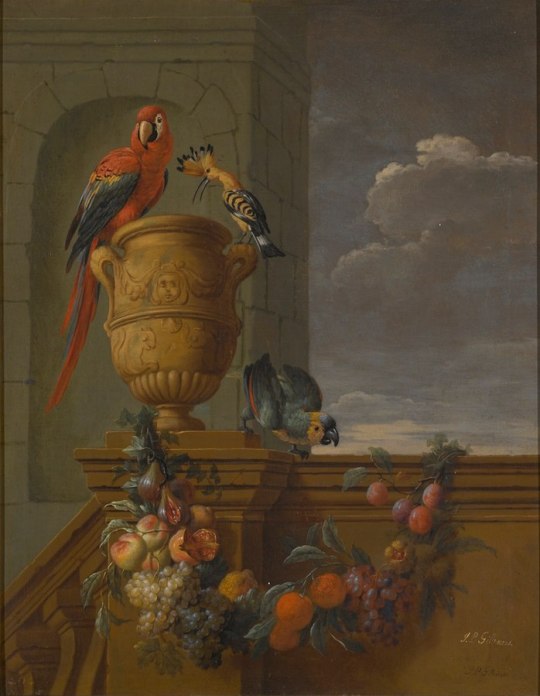
Jan Pauwel Gillemans the Younger, A Macaw and a Hoopoe Perched on a Stone Urn with a Parrot on the Balustrade From Which Hangs a Swag of Fruit, between 1665 and 1702, oil on canvas, 63 x 49.6 cm, sold at Sotheby's on 8 December 2011, London
Source: Wikimedia Commons
#art#painting#jan pauwel gillemans the younger#still life#still life with birds#fruit still life#17th century#late 17th century#17th century art#17th century painting#17th century still life#baroque#baroque art#baroque painting#baroque still life#Flemish baroque
4 notes
·
View notes
Text
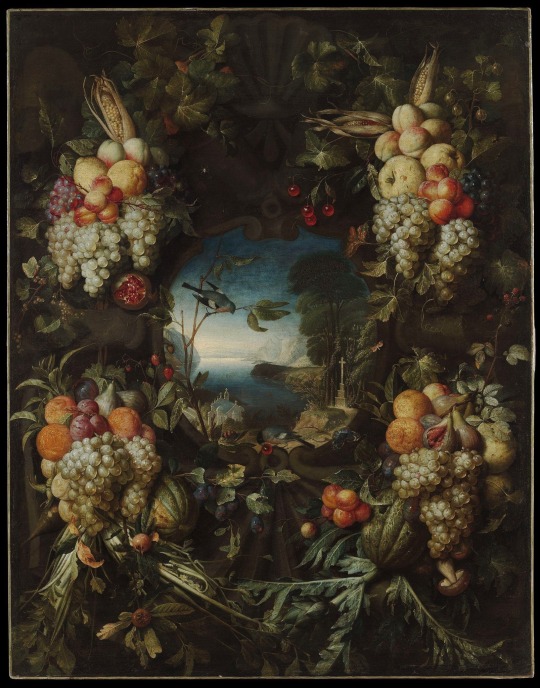
‘Garland of Fruit Surrounding a Cartouche Opening onto a Landscape', Jan Pauwel Gillemans the Elder, mid 17th century.
VAM
8 notes
·
View notes
Photo

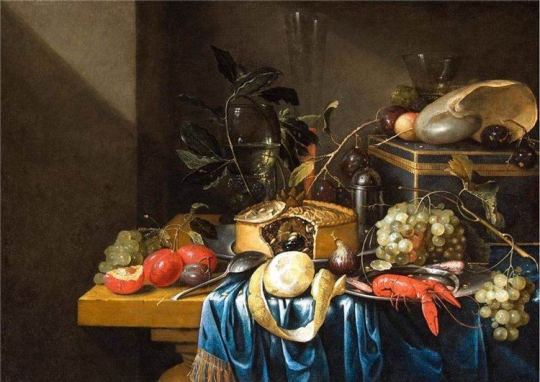
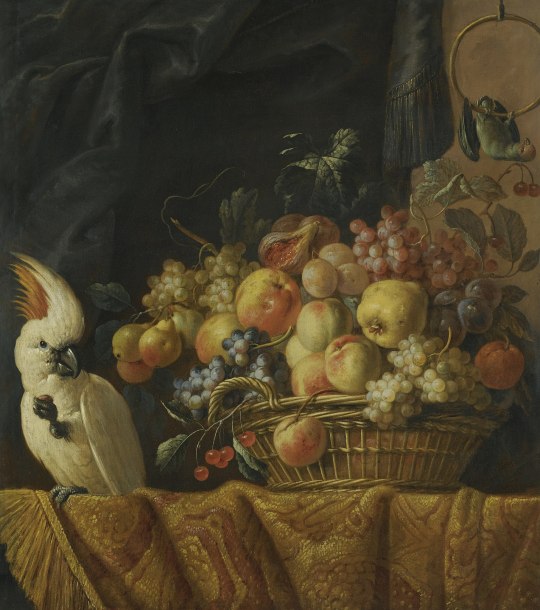
Jan Pauwel Gillemans the Elder (Antwerp, 1618 1675) Flemish goldsmith and still life painter
1 note
·
View note
Photo

Still Life of Fruit
by Jan Pauwel the elder Gillemans
Simon Carter Gallery, Woodbridge, Suffolk, UK
#Jan Pauwel the elder Gillemans#fineart#art#painting#artwork#masterpiece#fineartprint#gallery#museum
33 notes
·
View notes
Photo
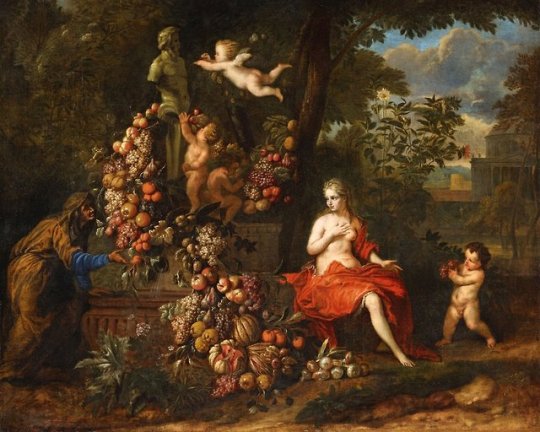
Vertumnus and Pomona (Allegory of Autumn), Jan Pauwel Gillemans the Younger (1651-1704)
#art#art history#Jan Pauwel Gillemans the Younger#Baroque#Baroque art#Flemish Baroque#classical mythology#mythological painting#Roman mythology#Vertumnus#Pomona#allegory#allegorical art#Flemish art#17th century art
141 notes
·
View notes
Photo
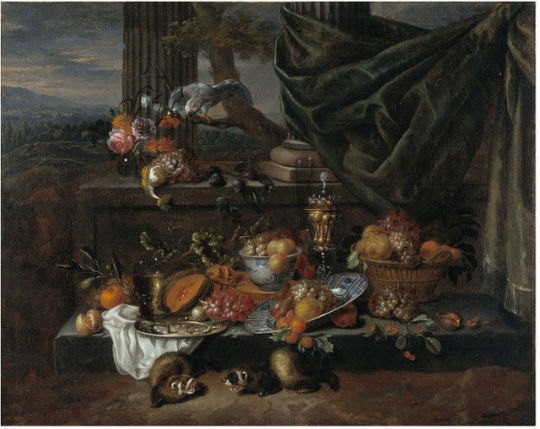
Jan Pauwel Gillemans (I) - Still Life with Fruit, a Parrot and Polecat Ferrets -
oil on canvas, Height: 55 cm (21.6 in); Width: 68.5 cm (26.9 in)
Victoria and Albert Museum, London, UK
Jan Pauwel Gillemans the Elder (Antwerp, 1618 - Antwerp, 1675) was a Flemish goldsmith and still life painter who is known for his fruit still lifes, flower pieces, vanitas still lifes and pronkstillevens.
His fruit still lifes of fruit and flowers were typically of a large format. A few were created on a smaller scale and were popular among contemporary collectors as cabinet pieces. An example is the Still life with lemons, grapes, a pipe and filleted fish (At Dorotheum Vienna on 9 April 2014, lot 566). This signed work shows that in the small format Gillemans preferred narrow views that put the focus on meticulously described objects.
27 notes
·
View notes
Photo
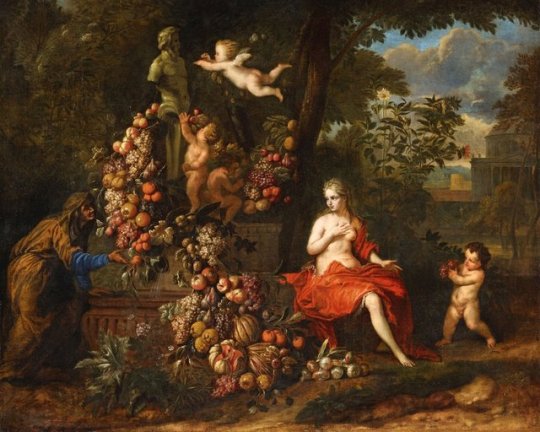
259. Pomona e Vertumno
Pomona era muito bela. Tinha muitos pretendentes, mas não queria nenhum. Só gostava de tratar dos pomares de fruta, cercados com vedação para que nenhum homem entrasse. Vertumno era o mais apaixonado. Inventou mil e um disfarces mas ela nunca o deixou entrar. Até ao dia em que se disfarçou de velha. Entrou e, elogiando-a, argumentou de muitas formas a necessidade de ela se casar. Até contou um caso que podia amolecê-la.
(Jan Pauwel Gillemans the Younger - Vertumnus and Pomona)
1 note
·
View note
Photo

Author: Gillemans, Jan Pauwel I. 1618-1675
School: Flemish
Title: Still Life (Vanity of Vanities)
Place: Flanders
Date: 1654
Material: canvas
Technique: oil
Dimensions: 97x140 cm
Acquisition date: Entered the Hermitage in 1929; handed over by the Antikvariat All-Union Association; originally in the Pavlovsk Palace
Inventory Number: ГЭ-4629
Category: Painting
Collection: European Fine Art
Subcollection: Flemish Painting of the 17th-18th Centuries
#Hermitage Museum#fine art#art history#sanat tarihi#güzel sanatlar#oilpainting#oil#canvas#painting#european#flemish#gillemans#vanity#still life#vanity of vanities
15 notes
·
View notes
Photo
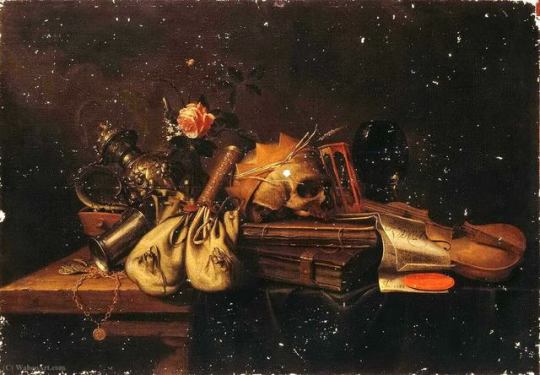
Jan Pauwel Gillemans the Elder - Still Life Vanitas
154 notes
·
View notes
Photo
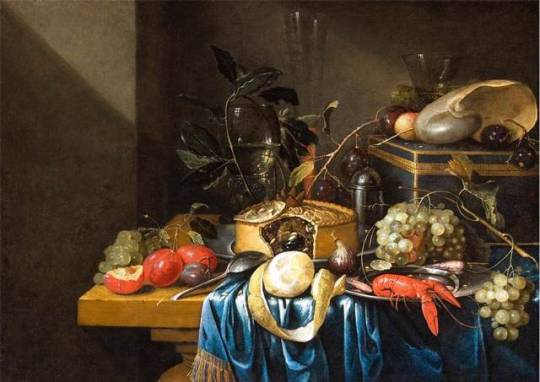
Jan Pauwel Gillemans the Younger
Flemish painter (b. 1651, Antwerpen, d. 1704, Amsterdam), Baroque
Still-Life. Oil on canvas, 58 x 83 cm
This still-life depicts fruit, a pie, wine glasses, a little lobster and a Nautilus shell. Every object is painted with the greatest attention to detail and reflections of light.
4 notes
·
View notes
Photo
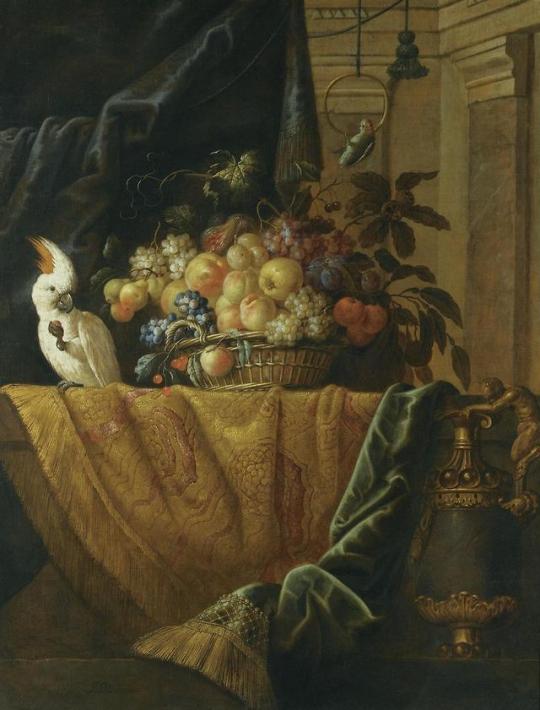
Jan Pauwel Gillemans II (1651-1704) A Still Life With A Basket Of Fruit And A Parakeet Upon A Ledge Draped (169,5 by 133 cm)
2 notes
·
View notes
Photo

Jan Pauwel Gillemans (I) - Still Life with Vegetables and Fruits -
oil on canvas, Height: 38.8 cm (15.2 in); Width: 49.8 cm (19.6 in)
Museum of Fine Arts, Ghent, Belgium
Jan Pauwel Gillemans the Elder (Antwerp, 1618 - Antwerp, 1675) was a Flemish goldsmith and still life painter who is known for his fruit still lifes, flower pieces, vanitas still lifes and pronkstillevens.
Jan Pauwel Gillemans the Elder was born in Antwerp as the son of Laureis and Clara van Baesel. His father was a goldsmith and a master of the Guild of Saint Luke of Antwerp. Gillemans was also destined to become a goldsmith and was sent to a family member in Liège to be trained in this craft. While this training included drawing, the young Gillemans wished to become a painter and returned to Antwerp after a stay of 7 to 8 years in Liège.
It is not known with whom he trained to become a painter. He became a master of the Antwerp Guild of St. Luke as the son of a member in the guild year 1647/1648.
In August 1648 Gillemans married Paulina Uyt den Eeckhout. The couple had four sons and four daughters. The needs of his large family forced the artist to open a gold shop. The deacon of the goldsmiths first refused to have him admitted as a goldsmith of the Guild but thanks to the intervention of Antwerp's city magistrate and the submission of his admission piece he was finally accepted in 1662. Gillemans did not abandon painting but continued to paint while running his gold shop. From the records of the Antwerp art dealer Forchondt for the years 1665 to 1673 it is known that Gillemans regularly provided the art dealer with fruit still lifes and garlands with herrings or lobsters for the export.
He was the teacher of his son Jan Pauwel Gillemans the Younger and Jan Frans van Son, who was the son of the prominent still life painter Joris van Son.
Gillemans died in Antwerp on 12 August 1675.
Willem Forchondt, or Guillam Forchondt the Elder (1608–1678) was a Flemish painter, cabinet maker and art dealer. His international art dealership played an important role in the spread of Flemish Baroque art in Europe and South-America. He changed the relationship between art dealer and artist by becoming himself involved in the organisation of the art production process.
26 notes
·
View notes
Photo
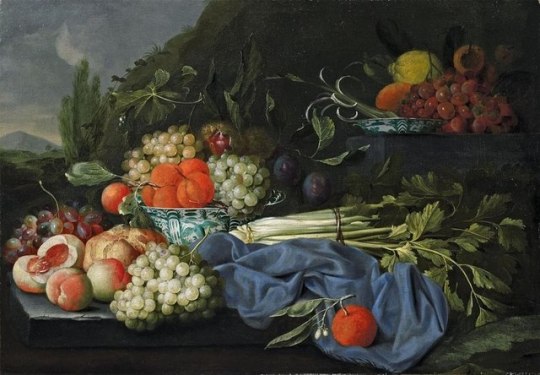
Jan Pauwel Gillemans (I) - Fruit still life with celery, peaches, oranges and grape in a china bowl -
Jan Pauwel Gillemans the Elder (Antwerp, 1618 - Antwerp, 1675) was a Flemish goldsmith and still life painter who is known for his fruit still lifes, flower pieces, vanitas still lifes and pronkstillevens.
The known work of Gillemans is limited. Gillemans was a specialist still life painter who is known for his heavy garlands with fruits and flowers set on a neutral background. He also painted pronkstillevens (i.e. sumptuous still lifes of luxurious objects), vanitas still lifes and garland paintings.
His work shows that he was in contact with the circle of Jan Davidszoon de Heem, a Dutch still life painter who was active in Antwerp from the mid-1630s. Typical characteristics of his work are the studied compositions, beautifully harmonious colours, accurate depictions of various of fabric and detailed displays of flowers and vegetables in all their diversity.
Some of his works are pronkstillevens, the sumptuous still lifes that were popular in Flanders and the Dutch Republic from the 1640s. A representative example in this genre is the Pronk still-life with fruit and a lobster, a lute on a chair, a landscape seen through a colonnade beyond (At Christie's London on 3-4 July 2012, lot 152), which represents a table laden with fruit, a ham, a lobster, a lute on a chair all placed in front of a landscape visible beyond a colonnade. Pronk still lifes are often interpreted as having a vanitas meaning.
16 notes
·
View notes
Photo
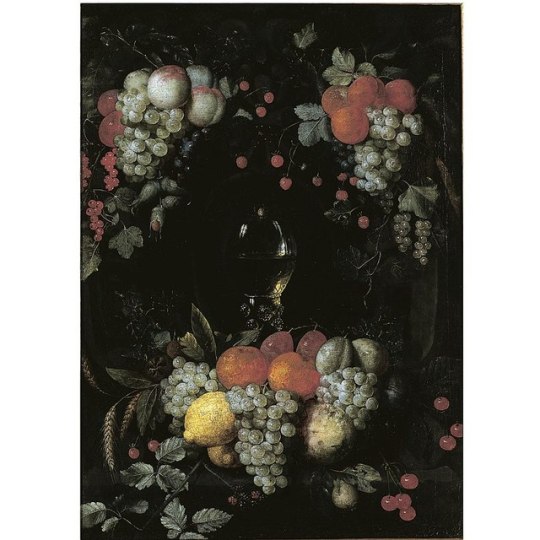
Jan Pauwel Gillemans (I) - A still life with a Roemer, oranges, grapes, plums, lemons and other fruit in a niche surrounded by garlands of fruit -
Jan Pauwel Gillemans the Elder (Antwerp, 1618 - Antwerp, 1675) was a Flemish goldsmith and still life painter who is known for his fruit still lifes, flower pieces, vanitas still lifes and pronkstillevens.
A number of his still lifes fall into the category of 'garland paintings'. Garland paintings are a type of still life invented in early 17th century Antwerp by Jan Brueghel the Elder and subsequently practised by leading Flemish still life painters, and in particular Daniel Seghers. Paintings in this genre typically show a flower or, less frequently, fruit garland around a devotional image or portrait. Garland paintings were usually collaborations between a still life and a figure painter. The figure painter would take care of the figures inside the cartouche while the still life painter was responsible for the flower or fruit garland. The names of the collaborators of Gillemans on his garland paintings are not generally known but a collaboration with Thomas Willeboirts Bosschaert is presumed.[ An example of Gillemans' work in this genre is the Garland of Flowers Surrounding a Cartouche Containing an Angel's Head and the Holy Sacrament (Victoria and Albert Museum). The garland includes thistles, grains, grapes and other flowers and fruit that allude to the Passion of Christ and to the Sacramental bread and wine of the communion which is depicted in the centre of the composition.
15 notes
·
View notes
Photo

Cornelis Mahu - Dessert -
Cornelis Mahu (1613 – 16 November 1689) was a Flemish painter of still lifes, genre paintings and seascapes who showed a very high level of craftsmanship in his compositions.
An important influence on his still lifes were the monochromatic "breakfast pieces" (ontbijtjes) or 'banquet pieces' (banketjes) of the Haarlem school of still life painters such as Pieter Claesz and Willem Claeszoon Heda. He stressed realism in his still lifes. He also painted Flemish style still lifes more in the style of Jan Pauwel Gillemans the Elder.
A good example of his still lifes is the Still life with an orange on a pewter plate, a porcelain pitcher, a glass, bread and a box of tobacco on a table (sold at the De Jonckheer Master Paintings). It shows in its arrangement of the various elements an influence of the Haarlem style. The work captures the spectator's eye with its vibrant contrasts of light and dark (chiaroscuro). The still life conveys the implicit message of vanitas so typical for northern European still lifes of the time. This message is conveyed through the usual symbols of the genre: the cut orange, which evokes the passing of life that is bitter in essence, and meaningless if not combined with a higher spiritual reality, and the burning candle, which inexorably measures time and the limits of our material and sensual aspirations.
35 notes
·
View notes